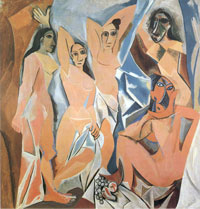
WEIGHT: 64 kg
Breast: Large
1 HOUR:120$
Overnight: +90$
Services: Humiliation (giving), BDSM (receiving), Facial, Massage Thai, Massage erotic
Beth Harris and Dr. Figure 1. And praise it they did. This was just too much for the young Spaniard. Figure 2. The figures are uncrowded. They describe flowing arabesques that in turn relate to the forms of nature that surround them. In very sharp contrast, Picasso, intent of making a name for himself rather like the young Manet and David , has radically compressed the space of his canvas and replaced sensual eroticism with a kind of aggressively crude pornography note, for example, the squatting figure at the lower right.
His space is interior, closed, and almost claustrophobic. Here are five prostitutes from an actual brothel, located on a street named Avignon in the red-light district in Barcelona, the capital of Catalonia in northern Spain—a street, by the way, which Picasso had frequented.

Instead, the artist chooses deeper tones befitting urban interior light. Gone too, is the sensuality that Matisse created.
Picasso has replaced the graceful curves of Bonheur de Vivre with sharp, jagged, almost shattered forms. In fact, a number of artists stopped inviting him to their studio because he would so freely and successfully incorporate their ideas into his own work, often more successfully than the original artist. While that analogy might be a little coarse, it is fair to say that he had an enormous creative appetite. One of several historical sources that Picasso pillaged is archaic art, demonstrated very clearly by the left-most figure of the painting, who stands stiffly on legs that look awkwardly locked at the knee.

Her right arm juts down while her left arm seems dislocated this arm is actually a vestige of a male figure that Picasso eventually removed. Her head is shown in perfect profile with large almond shaped eyes and a flat abstracted face. She almost looks Egyptian. In fact, Picasso has recently seen an exhibition of archaic an ancient pre-classical style Iberian from Iberia—the land mass that makes up Spain and Portugal sculpture at the Louvre.





































